现实世界制药数据的时间分布变化:QSAR模型中不确定性量化的含义
IF 5.4
引用次数: 0
摘要
定量构效关系(QSAR)模型预测的不确定性估计可以通过确定有前途的实验和允许有效分配资源来加速药物发现过程。有几种计算工具可以估计机器学习模型中的预测不确定性。然而,与i.i.d设置的偏差已被证明会损害这些不确定度量化方法的性能。我们使用真实世界的制药数据集来解决在现实分布随时间变化的背景下对不确定性量化方法进行全面、大规模评估的迫切需要。我们研究了几种常用的分类模型不确定性估计方法的性能,包括基于集成的方法和贝叶斯方法。此外,我们使用这个真实世界的设置来系统地评估标签和描述符空间中的分布变化及其对不确定性量化方法能力的影响。我们的研究揭示了显著的变化随着时间的推移,在标签和描述符的空间和转移的幅度和化验的性质之间的明确联系。此外,我们还表明,明显的分布变化会损害QSAR模型中常用的不确定性量化方法的性能。这项工作强调了识别不确定性量化技术的挑战,这些技术在现实世界数据引入的分布变化下仍然可靠。本文章由计算机程序翻译,如有差异,请以英文原文为准。

Temporal distribution shift in real-world pharmaceutical data: Implications for uncertainty quantification in QSAR models
The estimation of uncertainties associated with predictions from quantitative structure–activity relationship (QSAR) models can accelerate the drug discovery process by identifying promising experiments and allowing an efficient allocation of resources. Several computational tools exist that estimate the predictive uncertainty in machine learning models. However, deviations from the i.i.d. setting have been shown to impair the performance of these uncertainty quantification methods. We use a real-world pharmaceutical dataset to address the pressing need for a comprehensive, large-scale evaluation of uncertainty quantification approaches in the context of realistic distribution shifts over time. We investigate the performance of several popular uncertainty estimation methods for classification models, including ensemble-based and Bayesian approaches. Furthermore, we use this real-world setting to systematically assess the distribution shifts in label and descriptor space and their impact on the capability of the uncertainty quantification methods. Our study reveals significant shifts over time in both label and descriptor space and a clear connection between the magnitude of the shift and the nature of the assay. Moreover, we show that pronounced distribution shifts impair the performance of popular uncertainty quantification methods used in QSAR models. This work highlights the challenges of identifying uncertainty quantification techniques that remain reliable under distribution shifts introduced by real-world data.
求助全文
通过发布文献求助,成功后即可免费获取论文全文。
去求助
来源期刊

Artificial intelligence in the life sciences
Pharmacology, Biochemistry, Genetics and Molecular Biology (General), Computer Science Applications, Health Informatics, Drug Discovery, Veterinary Science and Veterinary Medicine (General)
CiteScore
5.00
自引率
0.00%
发文量
0
审稿时长
15 days
 求助内容:
求助内容: 应助结果提醒方式:
应助结果提醒方式:


